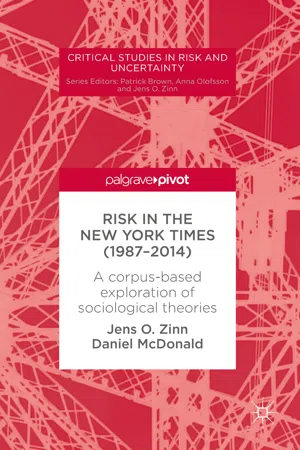There is little doubt that risk is a common experience of our times. Since Ulrich Beck (1986, 1992) in the mid-1980s suggested characterising advanced Western industrialised societies as Risk Societies, the world witnessed technical catastrophes from the explosion of the Piper Alpha oil production platform to the nuclear disasters in Chernobyl and Fukushima. Environmental issues entered front-stage with the debates and negotiations of the Intergovernmental Panel on Climate Change . Al-Qaida and later the Islamic State spread war in the Middle East and broad international terrorism to North America and Europe. National and international financial crises challenged the world economy. Large streams of migrants increased concerns about national security. Infectious diseases such as AIDS , SARS and the swine flu (H1N1) heightened the awareness of the threats of global pandemics.
All kinds of organisations have developed strategies to deal with the risks of uncertain futures, whether they are risks for society or risks for the organisation itself. Private companies and public administration assess, audit and manage the efficiency of their processes. Formalised procedures of managing risk have become key elements in public administration and private companies alike to optimise processes and legitimise performance.
Also in everyday life , the management of risk is a common experience: who to marry, what to study, which career to pursue, how to deal with chronic illness, how to overcome poverty and unemployment, how to invest income and prepare for retirement, whether to come out or to move country, where and how to give birth, whether to vaccinate the children and what school to choose or even what to eat or drink.
Often, global, national, organisational and individual risk management aims simply to identify and minimise risk . At the same time, however, risks are actively taken to change the world, increase profit, gain a valued identity or overcome an undesired situation (Zinn 2015). Sometimes, people take risks just for the joy of the risk-taking experience itself, as in extreme sports such as skydiving, BASE jumping and free climbing.
But has life really become riskier in recent centuries? Haven’t looming disaster and catastrophe always accompanied human existence (Mohun 2016)? Why is it that societies seem to experience more risk communication at times when people live in average longer, healthier and wealthier as ever before? The diversity of risk issues makes it difficult to understand what drives current debates about risk (Garland 2003). It seems too complex a task to find a shared core of meaning for all these different kinds and notions of risk referring to issues from possible harm to the mathematical calculation of and voluntary risk-taking .
However , there is a growing body of sociological theorising and research which make different claims about a shift towards risk and the reasons for and the forces behind it. This book empirically examines to what extent assumptions of different theories contribute to explain the social shift towards risk.
But how can we examine a general social shift which might take place everywhere in society or only in particular social domains? Since it is difficult to examine society as a whole, a decent starting point for the analysis of a social zeitgeist and changing discursive practices is needed. We turned to language , since language is a constitutive part of the social world (e.g. Berger and Luckmann 1967) and an important medium involved in the exchange, reproduction and shift of (social) meaning. In language, the past leaves traces, as does the imagined future. Language combines long-term social changes as well as short-term variations. In language, social structures are reproduced as much as social changes are anticipated. In short, language is an ideal source to examine how the past and the anticipation of the future are interwoven and change over time.
While language is a rich resource for research, it also comes with difficulties. It seems impossible to create a sample of language that is representative of an entire culture or point in time (Biber 1993). How much written and spoken language, from what regions, should be included? Which genres of written text have to be included? There is no uncontested answer to these questions. Therefore, corpora are often built for a particular research purpose, and their composition is justified based on the specific needs of a given project.
We have turned to the print news media , since they play a key role in people’s knowledge and awareness of risk. Many risks are intangible, or difficult to identify, requiring scientific research to make them socially accessible. They are only known because they are communicated and socially represented. This is similar to many everyday life issues, of which we are only made aware through media reports. Even though the media follow their own rationale when producing news, they do not only influence or set the agenda of public discourses,1 but also reflect what is going on in a society and are influenced by social players as important information sources such as politicians and researchers.2 Even though the news is shaped by a wide range of factors, such as the genre and editorial stance of a newspaper, news plays a key role in public debates about risk. Thus, digitised media archives provide an excellent source for analysing social change as it is reflected in discursive changes in the news media.
We have chosen The New York Times (NYT) for our analysis, since it is a leading global news source, influencing US and international debates. The NYT provides high-quality journalism, spanning economic, social and political issues, from a more or less balanced/centrist perspective.3 The NYT has been in consistent operation for over a century, with relatively little disruption in style and political stance. We, therefore, assume that general social changes, rather than short-term changes in internal policies, dominate observable linguistic shifts in the news coverage of the NYT (Zinn and McDonald 2016).
In the following chapte...
